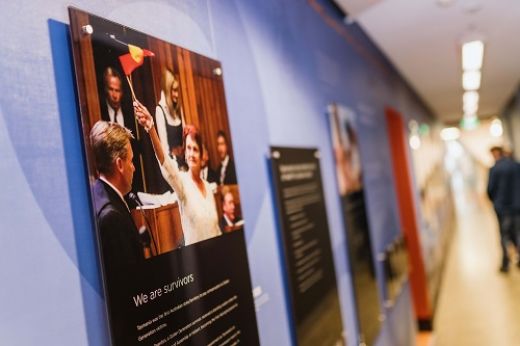
A timeline installation acknowledging the history of Tasmanian Aboriginals’ health and wellbeing, from the impact of colonisation to their continuing survival, strength and culture, was launched on 24 September.
The timeline - takara milaythina lutruwita nika paywuta = walked this country forever – will be situated permanently in the Medical Science Precinct at the University of Tasmania’s College of Health and Medicine.
The 2.5 metres high, 22-metres long installation explores the story of palawa people in lutruwita (Tasmania).
Through historical records, images, personal stories and insights, the timeline traces how Tasmanian Aboriginal ancestors lived on Country, while also exploring the impacts of change to their health and traditions.
The timeline is a collaboration between the Tasmanian Aboriginal community, the University’s College of Health and Medicine and Rural Clinical School and the University’s Office of Pro Vice-Chancellor (Aboriginal Research and Leadership).
“The Medical Science Precinct includes the colonial history of the site through information and artefacts, however it did not showcase or explore the history of the First Peoples on the site,” Professor Denise Fassett, Executive Dean - College of Health and Medicine, said.
“Our aim was to highlight and embed the story of the palawa people in lutruwita through the installation, and help provide a more culturally safe environment for students, staff and visitors.
“The timeline also acknowledges the difficult history around the medical profession and interaction with Tasmanian Aboriginal people, and aims to build a new understanding and mutual respect of equality, safety and collaboration.”
Distinguished Professor Maggie Walter, Pro Vice-Chancellor (Aboriginal Research and Leadership), said the timeline reflects the University’s approach in providing a vibrant, intellectual and highly visible Indigenous, especially Tasmanian Aboriginal, presence.
“The timeline not only provides a historical context for non-Indigenous people, but a source of recognition, pride and visibility for our Aboriginal and Torres Strait Islander staff, students and visitors to the site,” Professor Walter said.
“It is an extraordinarily powerful visual display of an intellectual, valued, vibrant Indigenous presence in not only the College of Health and Medicine, but across the University community.”
The installation was designed by graphic designer Sarah Owen, in consultation with a project reference group including members of the Aboriginal community and stakeholders.
Members from Tasmania’s Aboriginal community joined guests and University staff and students for today’s launch.
As part of the launch, an exhibition featuring historical and contemporary Tasmanian Aboriginal cultural objects and artefacts will be on display in the precinct’s main foyer and form part of the University’s permanent collection.